
Female Ruler Sporting Rare Diadem Unearthed at Bronze Age Palace
Archaeologists from the Universitat Autònoma de Barcelona have discovered Western Europe’s first Bronze Age palace in Murcia, Spain. The site also holds a unique burial including a probable female ruler who sported her rare silver crown-like object, a diadem, all the way to her grave.
The Bronze Age site was uncovered at La Almoloya in Murcia, Spain in 2014 and the lavish burial has been dated to around 1700 BC. It includes a female, a male, and an assortment of prestigious grave goods that were all placed inside a large jar which was found beneath the floor of a room at what has been called the first Bronze Age palace in Western Europe. The research team believes that the richly adorned woman was a female ruler in the Early Bronze Age El Argar society.
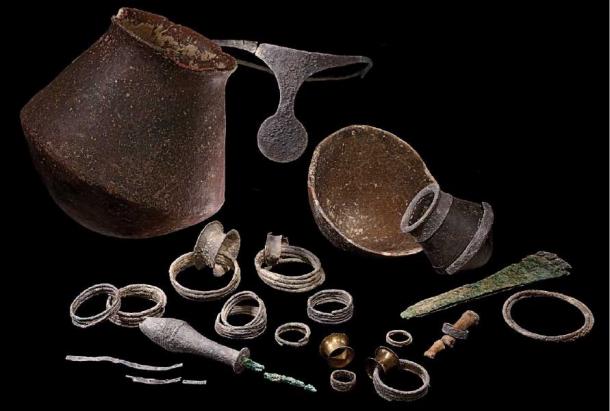
A selection of the grave goods. (credit: J.A. Soldevilla, courtesy of the Arqueoecologia Social Mediterrània Research Group, Universitat Autònoma de Barcelona /Antiquity Publications Ltd)
Discovering More About the Woman and the Man in the Jar
An Antiquity press release notes that this burial at La Almoloya is “one of the most lavish Bronze Age graves ever found in Europe.” The jar burial has been radiocarbon dated to the mid-17th century BC, the golden age of Argaric society. It features animal offerings, gold and silver objects of exceptional quality and the remains of a female and a male. The study authors mention in their paper that this grave was so rich that the 230 grams of silver objects alone would have been enough to pay the daily wages of 938 workers at the time!
- Archaeologists discover Bronze Age palace and huge trove of grave goods in Spain
- Killer Queens: 5 of Ancient History’s Most Outstanding Female Rulers
The remains of the female - aged 25–30 when she died - were also adorned with silver bracelets and rings, along with the diadem, when she was buried.
The male, aged 35–40, was buried wearing a copper bracelet, silver hair fasteners, and golden earlobe plugs. Analysis of their skeletal remains shows traces of cinnabar, which may have been used to dye their clothing or burial shrouds, or was used as body paint.
All of these elements prove that these were elite members of their society, with the female holding particular importance, though her exact role is still a mystery.
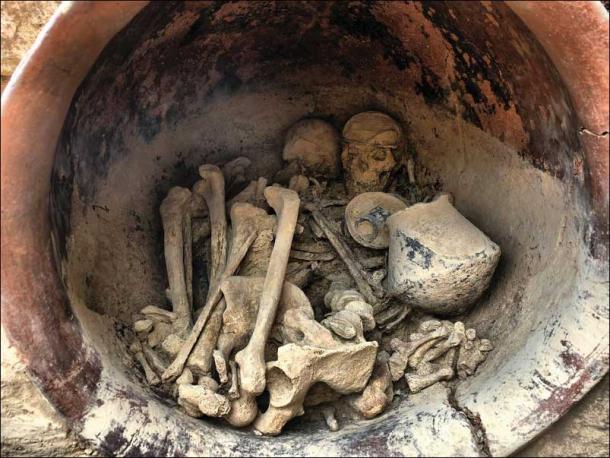
View of the interior of the grave, note the diadem on the female skull. (credit: Arqueoecologia Social Mediterrània Research Group, Universitat Autònoma de Barcelona/Antiquity Publications Ltd)
Rihuete Herrada told Ancient Origins that double burials are known at Bronze Age Argaric sites, but only make up around 10-20% of the graves at each site.
The researchers also doubt that sacrifice was involved in this double burial, however Rihuete Herrada says, “When two people are buried together that, of course, can be one of the interpretative options: somebody has died and the other person gets killed to become her/his companion. Of course this killing can be performed by means of poisoning or under untraceable means, but that will be negative evidence.” But, according to Rihuete Herrada, “we have no positive evidence supporting a sacrifice, neither in this period nor in the preceding one.”
When the remains were examined, the researchers discovered that the female suffered from several congenital abnormalities, along with a possible pulmonary infection at the time of her death.
The male’s skeleton also showed signs of extensive wear and tear and the team believes that he probably rode horses a lot. They also found signs of a traumatic injury on the man’s face, but it had healed a long time before he died. It’s believed that his death occurred shortly before hers.
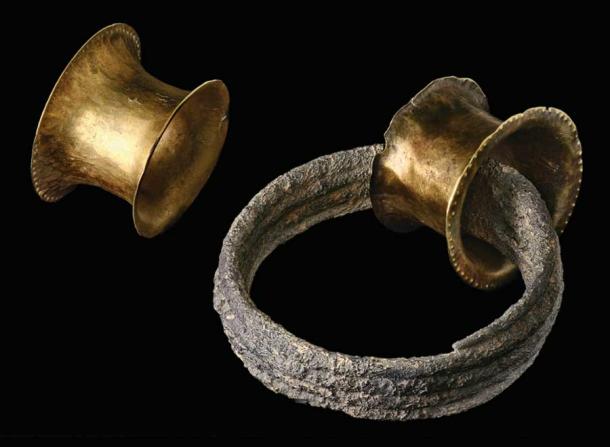
Golden earlobe tunnel-plugs from La Almoloya grave. (figure by J.A. Soldevilla, courtesy of the Arqueoecologia Social Mediterrània Research Group, Universitat Autònoma de Barcelona/Antiquity Publications Ltd)
Finally, genetic analysis also revealed something surprising – the man and woman had produced a daughter, whose burial was discovered at another part of the site. This was another of the surprises at the site, and Rihuete Herrada has called it “one of the enigmas posed by genetic data.” She told Ancient Origins that:
“This has been the first evidence of biological relatedness ever discovered for an Argaric burial, so it came as a surprise that parents and children were not buried close by, as it had been anticipated.”
The cause of the infant’s death is unknown, but may be due to an infectious disease, which is said to be responsible for high infant mortality rates at the time, but leaves no skeletal trace.
The First Bronze Age Palace in Western Europe
La Almoloya was part of the El Argar society, which flourished from 2200 - 1550 BC in the south-east of Iberia. It was apparently a palace where the ruling class lived their lives and carried out their business until it was destroyed by a fire, shortly after the female ruler was interred. It is located about 90 km (56 miles) from the eponymous site of El Argar.
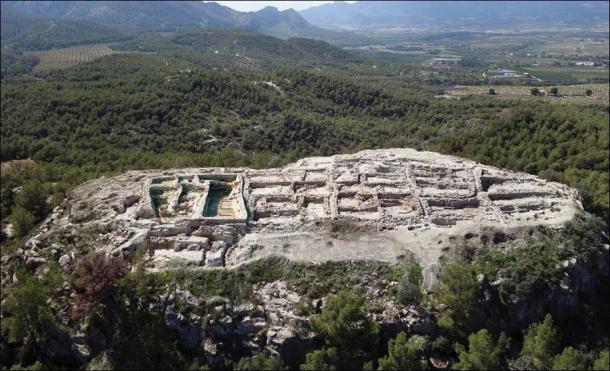
Aerial view of La Almoloya in 2015. (figure courtesy of the Arqueoecologia Social Mediterrània Research Group, Universitat Autònoma de Barcelona/Antiquity Publications Ltd)
Rihuete Herrada described the site’s main features, saying that this “is a palace in the political and economical sense of the word, as it has been applied to Eastern Mediterranean archaeology: a large architectural complex with different spaces devoted to different practices: workshops, food processing, storage, resting and meeting areas.”
The jar burial was found underneath an interesting room, which Rihuete Herrada says “could gather some 60 people seated in the benches all along the walls, had an extra-large hearth unparalleled in the domestic dwellings that had been recorded up to now and lacked the ordinary tools and storage facilities that are regularly found in spaces devoted to production.” The unique nature of this room led the researchers to calling it ““Assembly Hall” because it was specially fitted for that purpose and had a clear supradomestic character.”
This palace, the first of its kind, was just one of the El Argar society’s innovations. This Early Bronze Age society was also one of the first groups in the region to use bronze, develop complex urban centers with monumental structures, and to have had a highly stratified society.
This Diadem is an Extra Special Sign of Status
As noted above, the woman was buried with a lot of valuable jewelry and her remains were still wearing a diadem, which the researchers have noted as particularly important. Study co-author, Cristina Rihuete Herrada of the Department of Prehistory, Autonomous University of Barcelona, Spain told Ancient Origins:
“The diadem came as an extraordinary surprise. Hundreds of tombs had been dug but silver diadems of this type are an extremely rare object. All four known up to now appeared in the 19th century and came from El Argar site. So it was possible that this object was a specific feature of the ruling elite from that place. That is why La Almoloya diadem has contributed to clarify the political and, as we say, emblematic status of these diadems.”
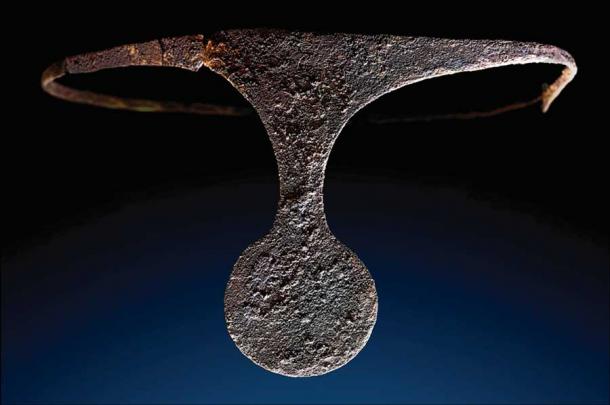
The silver Argaric diadem from La Almoloya. (credit: J.A. Soldevilla, courtesy of the Arqueoecologia Social Mediterrània Research Group, Universitat Autònoma de Barcelona/Antiquity Publications Ltd)
The researchers focused a lot of attention on the emblematic nature of the diadem in their paper, which is published in the journal Antiquity. For example, they write that “Diadems and crowns made of precious metals are some of the most easily recognized emblematic objects […] diadems are designed to be worn by individual people.” In Argaric society diadems have been included in the burials of select females and the “rarity, value, and prominence” of these artifacts are believed to identify the women as powerful and important.
Taking the social significance of the diadem and other exquisite grave goods and combining them with the location, the researchers speculate that the woman buried in the jar may have been “the top of a chain of command” at the site, according to the Antiquity press release. “These grave goods have allowed us to grasp the economic and political power of this individual and the dominant class to which they belonged,” the researchers said.
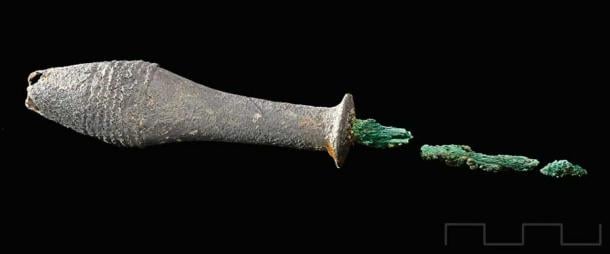
Copper awl with a handle coated in silver from La Almoloya grave 38, scale in centimeters. (figure by J.A. Soldevilla, courtesy of the Arqueoecologia Social Mediterrània Research Group, Universitat Autònoma de Barcelona/Antiquity Publications Ltd)
But the Diadem Also Poses Questions
The researchers wrote in their paper that the oldest examples of diadems have been interpreted “as symbols of rank, worn by ‘leaders’ or ‘chiefs’ with military power.” Finding diadems associated with women in the Argaric society poses the question of whether it may have been a class-based state society ruled by women. They write:
“In Argaric society, at the time that elite women were buried with diadems, elite men were preferentially buried with a sword and a dagger. These men were buried with fewer personal ornaments than females of the same class, and in no case did these male-associated objects have an emblematic character. As such weapons were the most effective means of enforcing political decisions, certain men would have played an executive role, even though ideological legitimation as well as—perhaps—the government, lay in certain female hands.”
- When a 2,000-Year-Old Iberian Settlement was Unearthed, The Remnants Confirmed a Tragic Story of Bravery, Death, and Suicide
- The Mystery of the Mayan Red Queen
So, the La Almoloya discoveries are providing not only a useful glimpse into life in this highly stratified El Argar society and at the Bronze Age palace, but also revealing unexpected political dimensions of that society, which the researchers call “unique in the contemporaneous Western Mediterranean and continental Europe.”
According to Rihuete Herrada, the last phase of La Almoloya has been completely explored, so the “thrilling goal” ahead of the research team is to explore the previous phases of the site, which are buried under the remains of this later one, and remain largely unknown.
The paper is published in the journal Antiquity.
Top Image: The interior of the grave (Arqueoecologia Social Mediterrània Research Group, Universitat Autònoma de Barcelona/Antiquity Publications Ltd) and the silver Argaric diadem from La Almoloya. (J.A. Soldevilla, courtesy of the Arqueoecologia Social Mediterrània Research Group, Universitat Autònoma de Barcelona/Antiquity Publications Ltd)
By Alicia McDermott















